Mini palaces in India are as intimate as a honeymoon and as indelible in memory as one’s first kiss. These dinky palaces are the lesser-known flower girls of regal India. Here are three of our favourites, where you can celebrate your honeymoon, an anniversary or just take a luxe break.
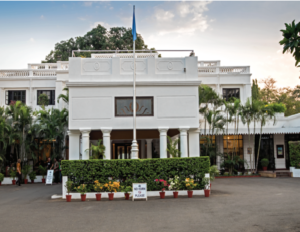
The gleaming marble Jehan Numa Palace hotel in Bhopal, in the heart of India, with its green courtyards, sturdy old trees, and air of gilded luxury, is pervaded by its rich past which wraps around one like a second skin.
Indeed, the past was our silent travel companion in the historic city of Bhopal, ruled for 107 years (from 1819 to 1926) by four women rulers, the gutsy Begums. Not only were the sword-wielding Begums able administrators, they left behind a rich legacy of grand palaces, mosques, hospitals, educational institutions and a syncretic Hindu-Muslim culture.
The Jehan Numa Palace was built in 1890 by General Obaidullah Khan, the second son of the last begum and commander-in-chief of the erstwhile Bhopal State Force. Rising like a white apparition on a slope of Shamla Hill, the mini palace is an artful melange of British colonial, Italian Renaissance and classical Greek architecture. The palace was imaginatively restored by the Begum’s grandsons Nadir and the late Yawar Rashid. A new portrait gallery with royal memorabilia, dating to the time when Bhopal was a princely state, adorns the walls of this 100-room alluring palace- hotel.
Blushing red bougainvillea trace a path over its immaculate white façade, yawning courtyards bloom with hospitable old trees where white wrought-iron chairs and benches invite guests to sit and watch the world go by. A 100-year-old mango tree provides a shady retreat and even has a restaurant named after it – Under the Mango Tree — which serves authentic mouth-watering Bhopali cuisine concocted from the hand-written recipes of the begums of yore.
The palace-hotel has a fragrant spa, swish restaurants and spacious period-style rooms that open onto lush green courtyards or a balcony that lassoes views of the swimming pool.
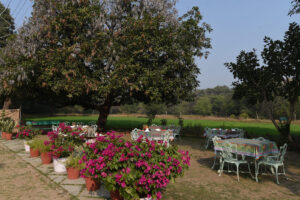
The palace-hotel’s identity as a former royal abode is constantly burnished by the former royals… A bonus: You may spy former royalty ride their thoroughbreds on the race track encircling the palace.
Shahpura Bagh: This mini royal residence of the former rulers of Shahpura, a small princely kingdom in Rajasthan, exudes understated grandeur, located as it is amidst lush parkland and a lake. Shahpura, situated between Udaipur and Jaipur, may not be your typical bucket-list destination.However, Shahpura Bagh, with its two stately mansions the 19th century Nahar Niwas and Umaid Niwas, is a boutique luxury homestay run by former royals which tourists should have on their radar. The picture-perfect residences, akin to white-washed cut-outs, rise amidst a luxuriant garden, lush woodland and a lake on the 45-acre estate.
Nahar Niwas is the family residence which also houses a dining area, lounge and a bar for guests. The nine suites in Umaid Niwas brim with charm – high ceilings, period furniture and arched windows in the Gothic style through which honeyed light filters in a gentle stream. Each suite is done up in a different colour palette and furnished with vintage four-poster beds, closets, writing desks, antique hat stands, and hand-picked locally sourced linen.
There are two villas as well, later additions, connected by an inner sun-lit courtyard furnished with banquettes and cushions. The bougainvillea-draped walls of the villas ensconce guests in a fragrant private space while the villa rooms are a soothing mix of vintage furniture and modern amenities. An outdoor shower and a private sit-out are luxe add-ons where you can listen to birds trill and gaze at the Instagrammable foliage-filled surrounds of the villas.

The terrace is perfect for watching the sun set over the vast estate studded with old-growth trees strung with a hammock or two, and interspersed with wheat fields and a swimming pool with picturesque pavilions for relaxation.
Indeed, you can find quietude here and it’s tempting not to stir out of the property. Meal times are convivial with tables set outside under a mango tree or indoors in Nahar Niwas lit by vintage chandeliers and crystal objets d’art.
The hosts often stroll past to chat with guests about brightly plumed birds that they may have sighted that day on the property or point out the jackal and jungle cat that often sneaks past thick foliage when dusk falls.
At Shahpura Bagh, the royal and the rural co-exist and sing a melodious duet for anyone who cares to listen.
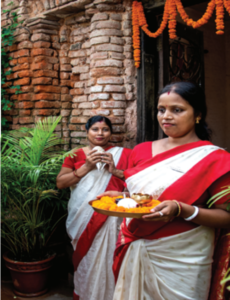
Rajbari Bawali was a dilapidated palace that once belonged to one of the richest, most powerful zamindari (landed gentry) families, a one-and-a-half-hour drive from Kolkata, West Bengal, India. It took Ajay Rawal, the current owner, seven years to restore the 350-year-old Rajbari Bawali and convert it into a 30-room boutique luxury hotel.
The interiors of this palace-hotel are fashionably eccentric and furnished with antiques that Rawal had collected over the years, thanks to his passion for old things. Yet everything seems to have a pre-ordained place in the general scheme of things. The corridors which overlook a splendid pillared courtyard are lined with Singer Sewing machines. A huge Louis Vuitton trunk, which perhaps sailed on gracious ocean liners of the past, occupies space in a corner outside a suite while the suites and rooms are kitted out with grand handcrafted four-poster beds hung with frilly layers of fabric, old sitars, drums, carved treasure chests, sinuous old metal chandeliers, sepia-tinted photographs, large winged armchairs, skylights, distressed chests of drawers… In the dining area, a polished grand piano occupies centre stage. It was sold to Rawal on condition that the then owner could play it whenever she visited Kolkata… There are many objets d’art with fascinating back stories.
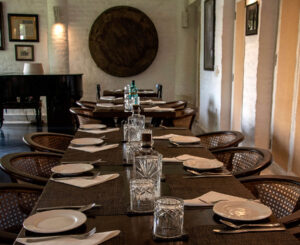
When Rawal first stumbled on the Rajbari, in 2009, it resembled the crumbling palace of a long- forgotten potentate. The roots of banyan trees coiled serpent-like around the grounds and had destroyed walls and several wings of the palace. Yet the historic pile was brushed with magic and, finally, after repeated visits, he succumbed to the poignant romance of the place and the promptings of his inner voice to save this splendid historic pile for posterity…
It was hard to believe that this stately mansion was located in an obscure hamlet that was once part of the Sunderbans. Back in the day, its wild topography was covered with swamp land and mangroves and dotted with a few isolated homes where Baul tribals lived. Tigers would stroll past, to sip water at the water holes and, even today, there is an aura of luxuriant fertility about this neighbourhood, carved out of the Sunderbans…

And the Rajbari adds to the fairy-tale ambience with bespoke experiences that offer a glimpse of the opulent Zamindari lifestyle of one of the richest and most powerful families in Bengal. Guests get to savour splendid Zamindari spreads and culinary demonstrations where you bite into living history. Come evening, take to the river on a vintage country boat with a sundowner and watch life unfold along the river banks as musicians strum your senses.
Every evening, back at the Rajbari, oil lamps are lit in the central courtyard, and a prayer ceremony, accompanied by the blowing of conch shells, pounding of drums, and the swirling of a tray-full of diyas, celebrates and signals the end of the day.

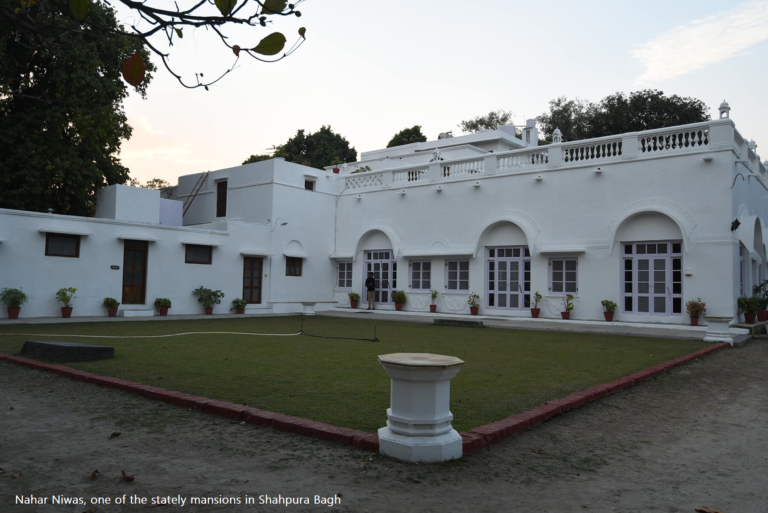
 Gustasp and Jeroo Irani are travel companions for whom life is a never-ending journey. Over the last 25 years they have travelled extensively across India and the globe, taking the rough with the smooth; sampling different cultures and cuisines. In the process they have trekked in the Australian Outback, slurped snake soup in HongKong, have danced with the Samburus in Africa, stayed with a local family in a Malay village, cracked the Da Vinci Code in Paris… For them, writing and photography are more than just freezing moments of that journey; it’s a passion.
Gustasp and Jeroo Irani are travel companions for whom life is a never-ending journey. Over the last 25 years they have travelled extensively across India and the globe, taking the rough with the smooth; sampling different cultures and cuisines. In the process they have trekked in the Australian Outback, slurped snake soup in HongKong, have danced with the Samburus in Africa, stayed with a local family in a Malay village, cracked the Da Vinci Code in Paris… For them, writing and photography are more than just freezing moments of that journey; it’s a passion.